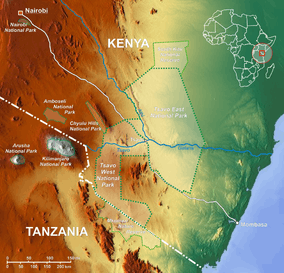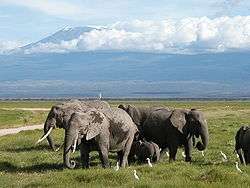Amboseli National Park
| Amboseli National Park | |
|---|---|
|
IUCN category II (national park) | |
 Location of Amboseli National Park | |
| Location |
Kajiado County, |
| Nearest city | Nairobi |
| Coordinates | 02°38′29″S 37°14′53″E / 2.64139°S 37.24806°ECoordinates: 02°38′29″S 37°14′53″E / 2.64139°S 37.24806°E |
| Area | 392 km² |
| Established | 1974 as a national park (as a reserve in 1906) |
| Visitors | 120,000 (estimated) (in 2006) |
| Governing body | Kenya Wildlife Service, Olkejuado County Council and the Maasai community |
Amboseli National Park, formerly Maasai Amboseli Game Reserve, is in Kajiado County, Kenya. The park is 39,206 hectares (392 km2; 151 sq mi)[1] in size at the core of an 8,000 square kilometres (3,100 sq mi) ecosystem that spreads across the Kenya-Tanzania border. The local people are mainly Maasai, but people from other parts of the country have settled there attracted by the successful tourist-driven economy and intensive agriculture along the system of swamps that makes this low-rainfall area (average 350 mm (14 in)) one of the best wildlife-viewing experiences in the world with 400 species of birds including water birds, pelicans, kingfishers, crakes, hammerkops and 47 types of raptor.[2]
The park protects two of the five main swamps, and includes a dried-up Pleistocene lake and semi-arid vegetation.
240 kilometers (150 miles) southeast from the capital city Nairobi, Amboseli National Park is the second most popular national park in Kenya after Maasai Mara National Reserve.
History
In 1883, Joseph Thompson was the first European to penetrate the feared Maasai region known as Empusel (meaning 'salty, dusty place' in Maa). He, too, was astonished by the fantastic array of wildlife and the contrast between the arid areas of the dry-lake bed and the oasis of the swamps, a contrast that persists today.
Amboseli was set aside as the 'Southern Reserve' for Maasai in 1906 but returned to local control as a Game Reserve in 1948. Gazetted a National Park in 1974 to protect the core of this unique ecosystem, it was declared a UNESCO Man and the Biosphere Reserve in 1991. The park earned $3.5 m (€2.9 m) in 2005. On 29 September 2005, Kenyan President Mwai Kibaki declared that control of the park should pass from the Kenya Wildlife Service to the Olkejuado County Council and the Maasai tribe. Some observers saw this as a political favour in advance of a vote on a new Kenyan constitution: legal challenges are currently in court. The degazetting would divert park admission fees directly to the County Council with shared benefits to the Maasai immediately surrounding the park.
Animals


The park is famous for being the best place in Africa to get close to free-ranging elephants.[3] Other attractions of the park include opportunities to meet Maasai and visit a Maasai village. The park also offers spectacular views of Mount Kilimanjaro, the highest free-standing mountain in the world.
Amboseli offers some of the best opportunities to see African wildlife because the vegetation is sparse due to the long dry months. Amboseli National Park is home to many species, including elephants, Cape buffaloes, impala, Masai lions, cheetahs, spotted hyenas, Masai giraffes, plains zebras and blue wildebeest among other African animals. There is also a host of Kenyan birds, both large and small.
The park has several rules to protect the wildlife: to never getting out of the vehicle, except at designated spots; to not harass the animals in any way; keep to the tracks; no off-road driving; and animals always have the right of way. The roads in Amboseli have a loose surface of volcanic soil that is dusty in the dry season and impassable in the wet season.
There is a small airport in Amboseli, the Amboseli Airport (HKAM).
See also
References
- ↑ "World Database on Protected Areas: Amboseli Nationalpark". sea.unep-wcmc.org. Retrieved 2008-07-28.
- ↑ http://www.amboselinationalpark.co.uk/facts-about-the-amboseli-national-park/ Amboseli National Park
- ↑ "ATE – Amboseli Trust for Elephants". elephanttrust.org. Archived from the original on 16 February 2008. Retrieved 2008-03-17.
External links
| Wikivoyage has a travel guide for Amboseli National Park. |
| Wikimedia Commons has media related to Amboseli National Park. |
http://www.amboselinationalpark.co.ke/ official website for Amboseli National Park
- Amboseli- Africa's Elephant Park – The Official Guide
- Kenya Wildlife Service – Amboseli National Park